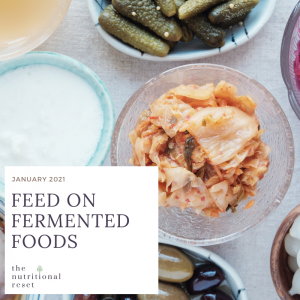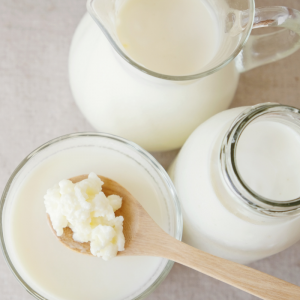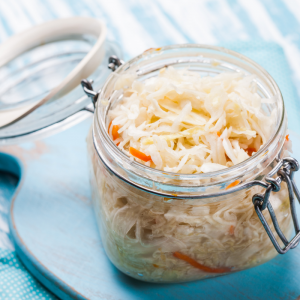 You may be wondering why I chose to focus on fermented foods to kick off my 2021 menus and for the January page of my 12 Healthy Habits Calendar. Well, there are two reasons:
You may be wondering why I chose to focus on fermented foods to kick off my 2021 menus and for the January page of my 12 Healthy Habits Calendar. Well, there are two reasons:
- First, we tend to do a number on our gut bugs (aka gut flora or microbiota) in December. This is because our traditional holiday diet shifts markedly to more refined carbs, added sugars and alcohol. And the holidays can be psychologically stressful, which may also have a detrimental impact. Fermented foods add beneficial live bacteria (probiotics) to our diets and give our gut microbiota a helping hand.
- Second, it’s a pretty simple healthy habit to adopt. And when we succeed at an initial change, it encourages and empowers us to take on another.
So why is feeding on fermented foods so easy to do? Because this is one of the few “prepared food” groups I’d recommend. While we certainly can ferment our own foods (and some do), it is not always practical. As a result, there are a number of high quality producers out there to meet demand.
Quality is key
But I do emphasize high quality. Take yogurt, for example. I recommend plain, full fat yogurt that lists only organic whole milk and live bacterial cultures on the label. That’s it – that’s all! If you want a fruit yogurt, then add your own fresh fruit (frozen and thawed berries are great for this). This way you avoid the added sugars that many producers add in notorious quantities (not to mention thickeners, stabilizers and sometimes even food colourings). And plain yogurt is more versatile. It can be used in savoury dressings and marinades for example.
So always seek out high quality and look for products that must be refrigerated. Refrigeration often indicates that there are live bacterial cultures present and halts further fermentation. Any product that has been pasteurized after fermentation has killed off any live bacteria it may have contained, which defeats the purpose. And the high heat required in canning may also destroy more fragile strains.
This month’s menu features kefir, tempeh and tamari (both of which are made from fermented soybeans) and sauerkraut. Read on for more about kefir and sauerkraut. This menu is gut-healthy not only for its probiotic content but also because of its high fibre content. Feed your gut bugs fibre and they will thrive!
You can drink your probiotics too
If you want to amp up the probiotic content of your meals even more, enjoy a fermented beverage with them. Sorry folks, I don’t mean wine. I’m thinking along the lines of a kombucha or perhaps a nice shrub. Rest easy, I am not suggesting you blender up your front hedge into a smoothie (although that would be impressively high in fibre). A shrub infuses cold-pressed fruit juice with organic, raw apple cider vinegar (which is a live food that contains probiotics). The idea is to mix it with sparkling water (or still if you prefer) to make a seriously refreshing beverage. As an added benefit, the vinegar aids digestion. One of my favourites is this Cucumber Lime Shrub from Ontario’s own Manning Canning Kitchens (they make great kimchi, sauerkraut and fermented pickles as well). Each bottle makes up to sixteen drinks.
Chocolate is also a fermented food – yay!
For dessert, savour a few squares of uber-dark chocolate. Our gut bugs love dark chocolate just as much as we do! Beneficial bacteria that live in the latter part of our colon ferment both the antioxidants and fibre in cacao, creating anti-inflammatory compounds that improve our health.
I hope this menu inspires you (and that January’s page in my 12 Healthy Habits Calendar reminds you) to feed on fermented foods this month. If you tend to the care and feeding of your gut bugs, they will reward you with improved digestion, immunity and mental health, to mention just a few benefits. Research in this area is accelerating and this list is likely to become even more impressive as the decade progresses.
Sign up here to receive the recipes from my Feed on Fermented Foods Menu.
Feed on Fermented Foods Menu
Breakfast: Pear Spice Overnight Oats (overnight oats take only a few minutes to prepare the night before and you have a grab-and-go breakfast the next morning; I often add walnuts and always add cacao nibs as I put them on pretty much everything – yum!)
Lunch: Rainbow Tempeh Bowls (the recipe calls for carrots, red pepper and roasted broccoli but feel free to use any veggies you like; I often make extra broccoli the night before and usually have pre-cooked portions of brown rice in the freezer, periodically making a big quantity in my Instant Pot – it pressure cooks rice perfectly, taking mere minutes of my time to set it up and portion the rice out afterward)
Dinner: Sausage & Sauerkraut Skillet (I love one-pan dinners as there is less to clean up; this is also a fab, fibre-filled brunch or lunch)
Join The Nutritional Reset community here to receive this month’s menu today (as well as each month to come)!
A few featured fermented foods …
 Kefir
Kefir
Kefir (pronounced “keh-FEAR”) is sometimes known as the champagne of milk products. That’s because fermenting the milk makes it fizzy. You make it by adding kefir grains (which are colonies of yeast and lactic acid bacteria that look like bits of cauliflower) to milk. These microorganisms then go to work fermenting the lactose sugars in the milk, turning it into kefir. The grains are then strained out to be used again. It tastes a fair bit like yogurt but is a thinner, more liquid consistency and, a mentioned, a bit fizzy.
As well as in these overnight oats, kefir can be used in smoothies, salad dressings, marinades and as a base for dips and cold soups. It’s also a great substitute for yogurt or buttermilk in baked goods and pancakes/waffles.
 Sauerkraut
Sauerkraut
Classic sauerkraut contains only cabbage and salt. The salt causes the water in the cabbage to release, creating a brine. Once submerged in this brine, the beneficial bacteria on the cabbage convert sugars in the cabbage into lactic acid, a natural preservative that inhibits the growth of harmful bacteria.
I like to add it (and kimchi, its spicy cousin) to my eggs at breakfast. It is delicious alongside any sausage, pork or potato dish and rather phenomenal with fish as well! And sauerkraut is great to gobble straight from the jar too.
Cooking your own food is the single most impactful step you can take to improve your health and energy!
I hope you enjoy the recipes in my Feed on Fermented Foods Menu. Sign up here to receive the download link for this latest Menu of the Month. And if you want to cook more of your own food but don’t know what to make or have the time to organize your own menus and shopping lists, The Nutritional Reset offers a meal planning service. It makes preparing tasty, nutritious meals a snap. Click here to find out more.